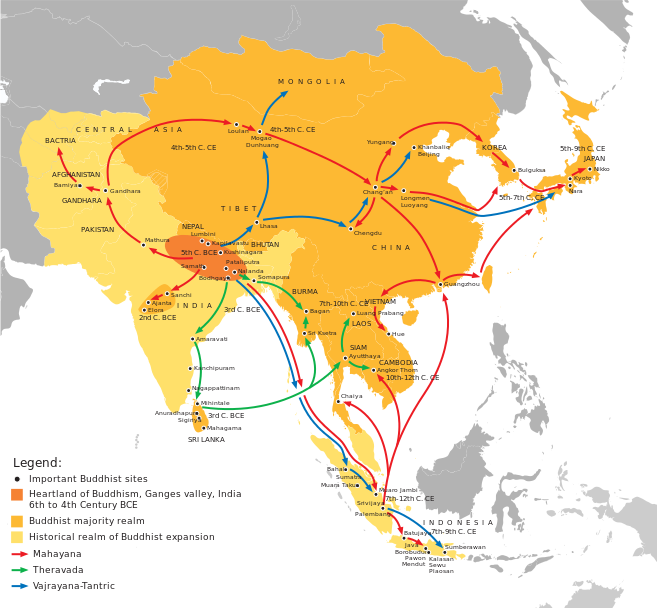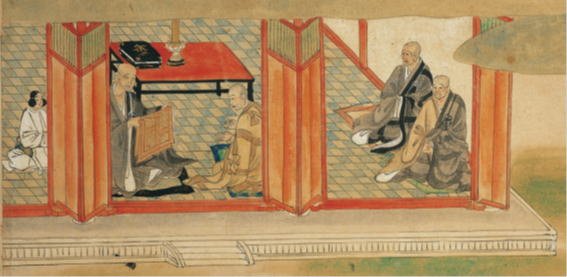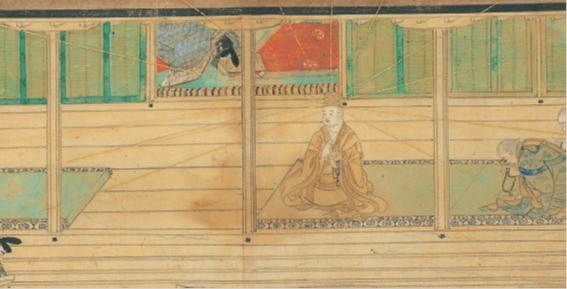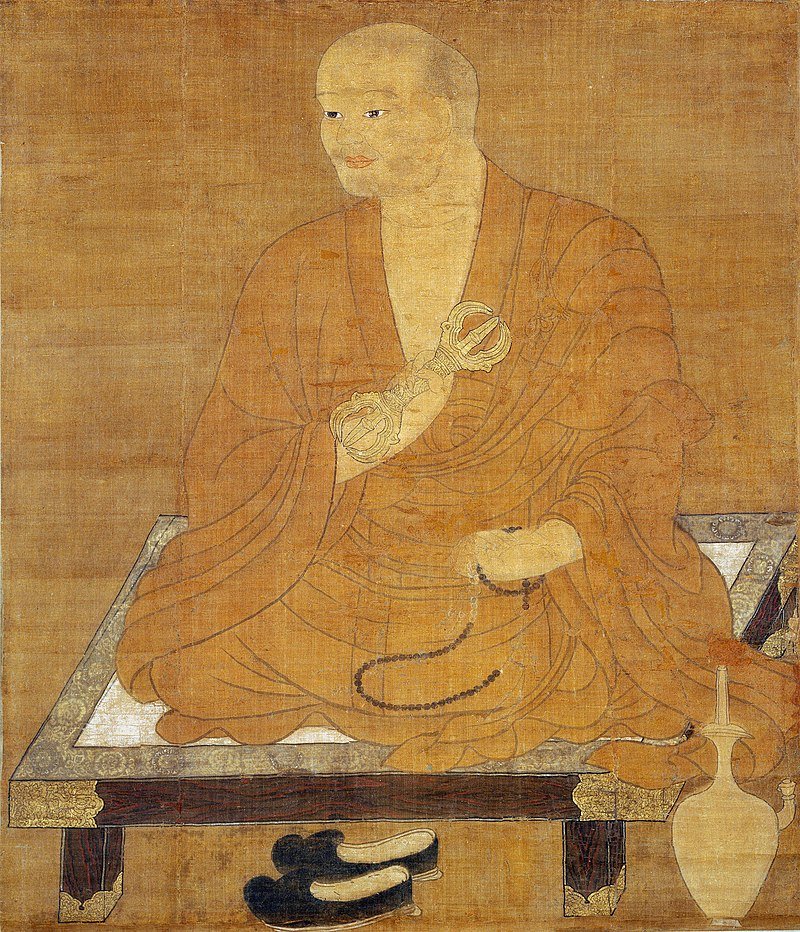
The Story of Shingon
The Origins of Buddhism
Buddhism was founded and recognized by Gautama Shiddhartha (the historical Buddha) who lived in India about twenty-five hundred years ago. The word “Buddha” literally means “one who has awakened to the truth” as well as the doctrines that are based on the teaching of one who had attained enlightenment. The basic doctrine of Buddhism describes how to be awakened to the truth of the universe and how to attain perfect enlightenment.
The content of this doctrine makes some religious experts say that Buddhism is not just a religion but also a philosophy. Others have also characterized Buddhism as a set of spiritual teachings and practices.The basic doctrine of Buddhism characteristically describes the importance of practices and experiences. The three guiding principals of this doctrine are the observance of the precepts, sitting in meditation and obtaining wisdom. In order to help people attain enlightenment (to become a Buddha), many scriptures were produced.
The “Twelve Causes”, “Four Noble Truths” and “Eightfold Path” are the some of the fundamental scriptures. More philosophical doctrines were added around the 1st century when Mahayana Buddhism was created.
The Mahayana
Buddhism was divided into two main branches as it began spread worldwide.
Buddhism, like many other religions, began to evolve over time and developed into many district groups. These different groups came from the same original doctrine of Buddhism but differ in teachings and the philosophy of how to become enlightened to the truth. Buddhism was divided into two main branches as it began spread worldwide. One stream (Mahayana) made its way from India to China, Mongolia, Central Asia, and then came to Japan via the Korean Peninsula during the 6th century. The other branch (Theravada) took course to the south as it moved from Burma to Thailand via Sri Lanka in the 11th century.
Mikkyo
Koyasan was founded by Kobo Daishi 弘法大師 as his ascetic sanctuary in 816 C.E.. His teaching is called “Mikkyo” or “Esoteric Buddhism”. Esoteric Buddhism emerged during the middle and the last period of the development of Buddhism in India.
Mikkyo (Esoteric Buddhism) and Shingon Buddhism
What is “Mikkyo”? Mikkyo is the Japanese word for Esoteric Buddhism and is often translated as “secret teachings”. The doctrines of Mikkyo are taught through masters of Mikkyo and the information or knowledge is transmitted spiritually according to the abilities of the practitioners. In contrast to Exoteric Buddhism (Mahayana Buddhism), in which the doctrines are taught through the use of textbooks, Mikkyo emphasizes that teaching through experience is the way to attain enlightenment. Another difference is that Exoteric Buddhism is typically taught in a large group setting and Mikkyo is usually taught person to person. The doctrines of Mikkyo have been transmitted and passed down through the lineage of the Esoteric Buddhism masters.
Over the course of time, the doctrines and practice of Buddhism became more clearly defined. Esoteric Buddhism (Mikkyo) was first established in India around the 1st century during the last period of the development of Buddhism. Indian Buddhism tried to regain its popularity.
Some historians point out that Indian Buddhism tried to regain its popularity by incorporating magic rituals similar to the rituals used in the Hindu religion. In fact, the original form of the Goma Fire Ritual (Homa) used in Mikkyo, came from Hinduism. Magic rituals were one of the important components during the early development of Esoteric Buddhism. During this time period the followers were likely to chant mantras and dharani (陀羅尼) to wish for material goods or fortunes as opposed to spiritual well being or the desire to attain enlightenment. Over the course of time, the doctrines and practice of Buddhism became more clearly defined.
In the early stages of Buddhism it was prohibited to worship an idol or image. Furthermore, it was considered impossible to create an image that would capture the greatness of Buddha. Eventually, however, religious people began to seek a ground for their faith and create Buddhist images for use in worship. As the doctrines were manifested, more and more statues, pictures and figures were produced. In Mikkyo, the main images are the Five Buddhas of Wisdom with Dainichi Nyorai (Mahavairocana) as the central Buddha. These Five Buddhas of Wisdom can often be found in Buddhist mandalas. Over time, a multitude of Buddhas were identified with an equally diverse range of characteristics. Each image has its own special sacred connections and powers. In Shingon Buddhism, visual images are used to help facilitate spiritual practice. Mudras, mantras, and mandalas are a necessary part of developing spiritual training. These three keys are essential to leading followers toward the potential of attaining enlightenment.
While the theories and doctrines of Esoteric Buddhism were continuing to develop, Kobo Daishi crossed the ocean to China seeking to advance his own understanding of Buddhism. Kobo Daishi was fortunate to visit the Qing-long Temple and was taught under the guidance of Master Huiguo, a patriarch of Esoteric Buddhism. After being initiated as the eighth master of Esoteric Buddhism, Kobo Daishi returned to Japan and was given permission by the Japanese court to establish a monastery in Koyasan for the practice of meditation and teachings of Esoteric Buddhism.
Kobo Daishi founded a new branch of Esoteric Buddhism known as Shingon with two main pillars in his teaching; 1, that everyone has the ability to attain enlightenment in this very lifetime (Sokushin Jobutsu); and 2, to bring eternal peace to the country of Japan.
Enlightenment in this Life
What does it mean to attain enlightenment in this very life?
“Sokushin Jobutsu” is the Japanese term for becoming a Buddha in this very physical body. This term is one of the main theories of Shingon Buddhism and distinguishes it from the other branches. Other doctrines of Buddhism require endless efforts over many lifetimes in order to attain enlightenment. Moreover, it is necessary to be reborn again and again in order to attain enlightenment. On the contrary, the teachings of Shingon Mikkyo preach that followers have the ability to become a Buddha in this real body in this life.
Kobo Daishi teaches that it is possible for anyone to attain enlightenment. Worldly desires often prevent people from realizing this ability to achieve Buddha-hood, and although it is up to the abilities of the individual practitioner to find their own way, the potential exists for everyone. Shingon Mikkyo teaches that we all have the ability to be free from concerns and isolate ourselves from any trouble by achieving enlightenment in this very life.
Kobo Daishi and Koyasan
Kobo Daishi 弘法大師 (Kukai 空海) was a renowned monk who established Shingon Buddhism during the Heian era. In 835, he entered into eternal meditation and in the year of 921 he was given the posthumous name of Kobo Daishi by Emperor Daigo. The meaning of the name Kobo Daishi recognizes his excellence as a teacher as well as his work and efforts to spread the word of the Esoteric Buddhism throughout Japan. Although both names are used interchangeably, Kobo Daishi is the name most commonly used by the followers of Shingon Buddhism.
Kobo Daishi became disenchanted with the secular world and began to develop a strong interest in Buddhism.
Kobo Daishi was born in 774 in the province of Sanuki (Kagawa Pref.) on Shikoku Island. When he was young, he studied Chinese classics and Confucianism under the guidance of his uncle, Ato-no Otari. When he was fifteen, he moved to the capital city to enter a government university where most of the graduates moved on to become bureaucrats. During his time at the university, Kobo Daishi became disenchanted with the secular world and began to develop a strong interest in Buddhism. Consequently, at the age of eighteen, he decided to live his life as a Buddhist monk.
When Kobo Daishi was thirty-one years old, he happened to read a scripture of Esoteric Buddhism called “Dainichi-kyo” (Mahavairocana Sutra). This sutra had a tremendous impact on him and thus he became very motivated to study more in depth about Esoteric Buddhism. Since Esoteric Buddhism was relatively unknown in Japan, Kobo Daishi knew he must go to China in order to gain a better understanding of the Esoteric teachings. Fortunately, Kobo Daishi was able to join a Japanese envoy in 804 that was traveling by boat to Xi’an (the capital of China at the time) to visit the Tang Dynasty. In spite of Kobo Daishi’s initial 20 year directive to study Buddhism in China, he returned to Japan after only two years with the mission from Master Huiguo to spread the teachings of Esoteric Buddhism throughout Japan. Kobo Daishi returned to Japan in the province of Tsukushi (Fukuoka Pref.), with a great number of religious textbooks and artworks. However, having disobeyed the 20 year directive from the government, he was not allowed to enter the capital city. After several years had passed, Kobo Daishi was finally permitted to enter the capital city. Immediately after being welcomed back into the capital city he proclaimed his devotion to propagating of the supreme doctrine of Esoteric Buddhism.
He dedicated himself to the work of creating an Esoteric Buddhism School
Kobo Daishi is also known as the father of Japanese culture. He is renown for his talents as a teacher, engineer, inventor, poet, calligrapher and creating the first public school in Japan. Kobo Daishi has influenced Japanese culture in many ways that can still be seen today. For example, Kobo Daishi directed the reconstruction of the “Manno-ike”(reservoir) in his hometown. This structure was remarkable in its scale, technology and still stands today. Kobo Daishi also established the first tuition free university for commoners (Shugeishuchi-in) in Kyoto.
This structure was remarkable in its scale, technology and still stands today.
Through his achievements and rising popularity, Kobo Daishi was summoned and requested to assist on a multitude of tasks and projects. Yet he never lost sight of his desire to create a monastic center for Shingon Mikkyo (Esoteric Buddhism). In 816, after receiving permission from Emperor Saga, Kobo Daishi officially founded the seminary community of Koyasan. Since its induction, he dedicated himself to the work of creating an Esoteric Buddhism School while providing spiritual support for the common people. Kobo Daishi entered into eternal meditation on March 21, 835, surrounded by his devoted disciples. He is believed to be alive and continues to provide relief to those who ask for salvation.
Koyasan Today
In 2004, Koyasan was registered through UNESCO as a World Heritage site. The official title is the “Sacred Sites and Pilgrimage Routes in the Kii Mountain Range”.
In the last 1200 years, the teachings, rituals and traditions in Koyasan havenot changed. Through the efforts of countless people, the community has been able to preserve its rich heritage and its customs, but there have been some notable changes that have occurred over time. Today there are 117 temples in Koyasan, but there used to be many more. Although many of the ancient buildings have survived for many years, some of the original buildings have been lost due to fire.
Another significant change occurred in 1872. This was the year that the law prohibiting women to enter Koyasan was removed. This change not only brought women to Koyasan, but with them many other common people and children came to the mountain community. What was once a place only for male priests gradually transformed into a small town.
In 2004, Koyasan was registered through UNESCO as a World Heritage site. The official title is the “Sacred Sites and Pilgrimage Routes in the Kii Mountain Range”. Since being registered as a World Heritage site, more and more visitors from diverse countries have come to Koyasan to appreciate the rich history and its unique atmosphere. Although the essence of Koyasan has remained the same, nowadays all walks of life are able to live in peace at the site where Kobo Daishi founded this sacred place 1,200 years ago.






